It represents a tiny strand in Winnipeg’s sprawling web of concrete and asphalt streets.
For residents of the Waverley Heights neighbourhood, it marked the first time their pockmarked roadway had been earmarked for scheduled repair in more than four decades.
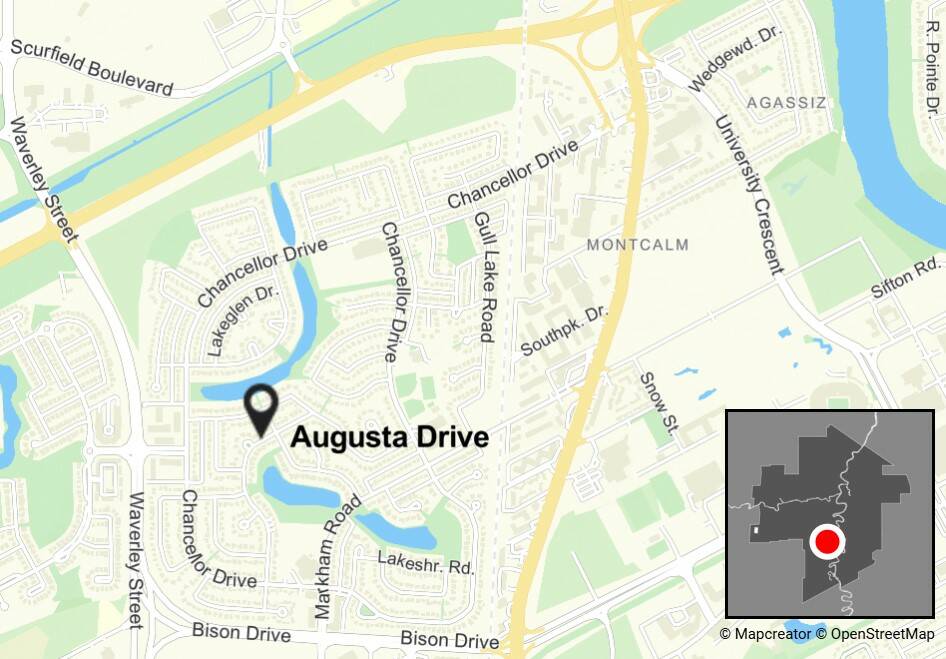
It’s a stretch of unsightly and unsafe pavement with which so many Winnipeggers could identify. Potholes — one five-feet wide and seven-inches deep — crumbling curbs and chunks of asphalt scarred the quiet residential street. It was clear the winding Augusta Drive was long past its best-before date.
What happened on Augusta Drive?
Construction crews tackled two ends of Augusta Drive: a roughly 500-metre stretch near Arthur A. Leach School that included Providence Place, and another 500-metre stretch at its southern end that included Greensboro Bay.
The two sides required different work, according to the City of Winnipeg’s public tender.
Construction crews tackled two ends of Augusta Drive: a roughly 500-metre stretch near Arthur A. Leach School that included Providence Place, and another 500-metre stretch at its southern end that included Greensboro Bay.
The two sides required different work, according to the City of Winnipeg’s public tender.
For the former strip, crews were tasked with planing the pavement, a “full-depth” pavement patching which included excavation, sub-base and base course installation and geotextile fabric, and placement of an asphalt overlay. They were to remove existing curbs and gutters and install wider replacements. Topsoiling and sodding was to be part of the program.
The latter stretch also required planing the existing asphalt, placing new asphalt overlay, and changing the curbs and gutters. There was no requirement for pavement patching, but crews were expected to install limestone surfacing material on shoulders.
Asphalt overlays are usually used when a road’s materials are “relatively intact,” said Ahmed Shalaby, a University of Manitoba civil engineering professor specializing in pavement design.
Concrete lasts longer than asphalt and is really durable, but it’s harder to repair, Shalaby noted. Asphalt can be “almost shaved off the surface” — it’s milled — and is easier to recycle.
Concrete is a harder material, making it more expensive to replace. But a well-used concrete road could last up to 40 years, compared to asphalt, which generally hits its maximum lifecycle at 20 years, Shalaby said.
He believes the city should employ a good balance of the two. It helps with price fluctuations, he said.
When it comes to drying time, concrete takes much longer. Concrete curbs, for example, may need 36 hours to harden, Shalaby said. Asphalt — hot when poured — can take three to four hours to cool.
Still, a seven- to eight-week window is needed for construction like Augusta’s, even when locals just see an asphalt overlay, he said. The existing concrete often needs repairs before asphalt goes on top; fluctuating temperatures and long-term wear and tear probably cracked the street.
Manitoba is a challenging place for roads.
“We see both ends of the scale… from extreme cold to extreme heat,” Shalaby said. “We end up having to do a lot of work in a very complex work season.”
Crews will stop when freezing temperatures are predicted. Even if the mercury doesn’t dip below zero, companies generally lean to the side of caution, Shalaby said. Construction during cold weather affects how road materials perform in the long run.
Winnipeg and its homeowners could save money by building more driveways and sidewalks from asphalt, Shalaby asserted: “a bike lane or a sidewalk doesn’t need to be built to the same standards of a heavy-traffic load.”
— Gabrielle Piché
“The whole road is just falling apart,” said Wes Kamyszek, who grew up on the street and was home visiting his parents this summer.
The City of Winnipeg budgeted $138.3 million for 150 kilometres of road, bridge and active transportation construction projects this year — ranging in scale from thoroughfares and bridges to less-travelled side streets. Augusta Drive, including forays down Greensboro Bay and Providence Place, accounted for one kilometre of that total — roughly 500 metres of work at each of its ends, while an equal distance in the middle was left untouched.
If a city were to be solely judged by the condition of its roads, Winnipeg would remain in a state of infamy. This year, crews filled a record 180,000 potholes. And that’s only the quick fix at surface level. Road renewal is a completely different beast — it often entails multi-million-dollar endeavours taking months, sometimes years, to complete, causing traffic snarls and detours that test the patience of motorists, residents and business owners alike.
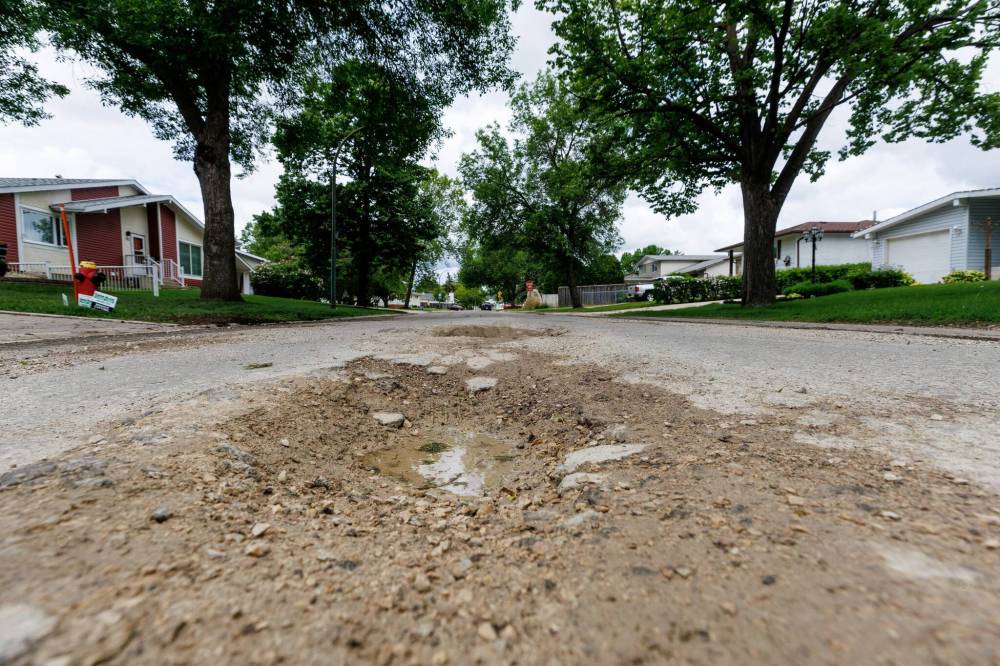
MIKE DEAL / FREE PRESS
The road conditions in June along the stretch of Augusta Drive between Lakeside and Chancellor drives show potholes, crumbling curbs and cracks in the pavement.
Earlier this year, the city revealed its infrastructure deficit has climbed to $8 billion, based on a 10-year capital project blueprint that is largely made up of unfunded proposals, such as a new Arlington Bridge, the Chief Peguis Trail extension and the widening of Kenaston Boulevard. Big-ticket items seemingly mired in endless debate.
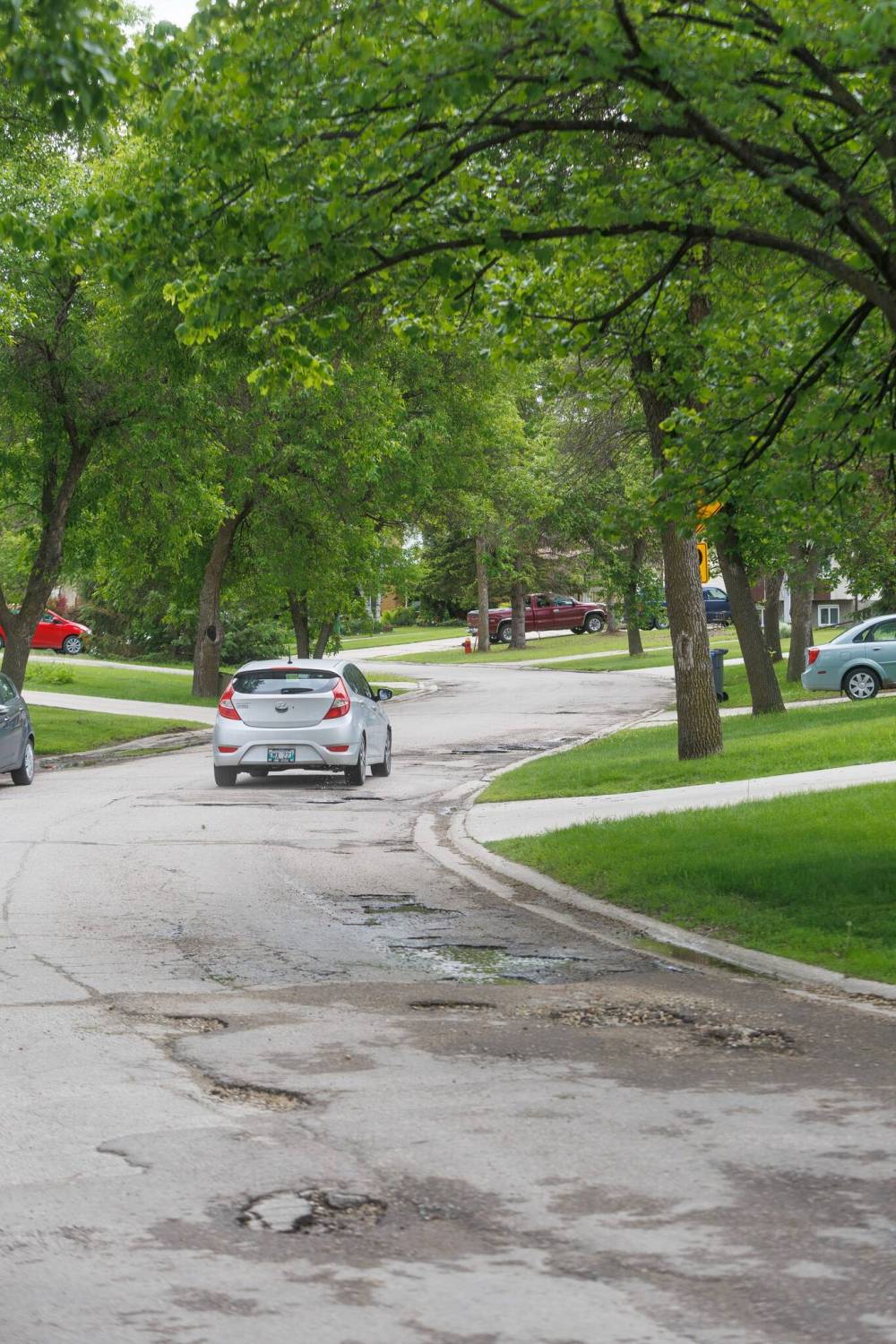
MIKE DEAL / FREE PRESS
Two ends of Augusta Drive, along with Greensboro Bay and Providence Place, were earmarked for repair this summer. The roadway had been in a state of disrepair for years.
Meanwhile, many residents simply ask, why does it take so long for their street, sidewalk or back lane — worn down by weather, time and neglect — to be fixed?
Augusta Drive, which was built in 1979 in the city’s then-newest southwesterly neighbourhood, finally came on stream for repairs this year.
The first barricade was up by Aug. 9; the last came down Thanksgiving weekend, though heavy equipment remained on the scene for several more days. In between, new curbs were built and two stretches of road repaved — a pace of construction that worked out to approximately 13.3 metres a day.
The Free Press visited Augusta Drive more than 25 times over four months, tracking its progression — and at times, the lack of it — and talked to residents, industry experts and city officials to try to better understand how street construction works in Winnipeg.
Like many of the city’s 8,300 kilometres of roads, there were bumps along the way.
The taillights burn red.
There’s a pause, then the vehicle slowly reverses from the “road closed” sign.
Beyond, a construction worker spray-paints lawns with pink lines to flag temporary survey markings. Another worker fires up a backhoe.
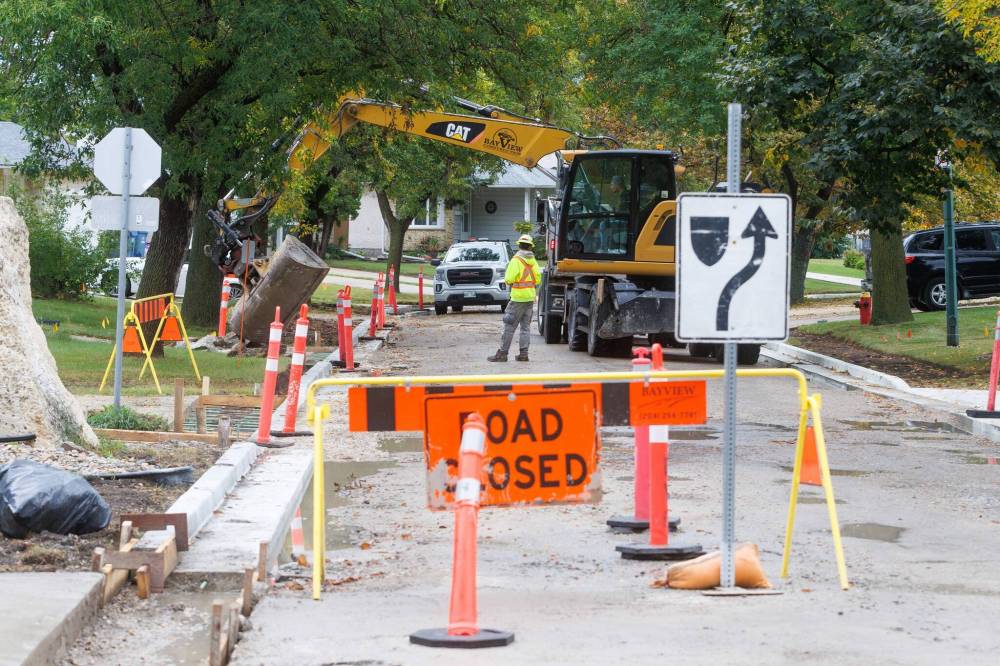
MIKE DEAL / FREE PRESS
Road construction crews work on the stretch of Augusta Drive between Lakeside and Chancellor drives in September.
Crews have occupied Augusta Drive, off and on, for a month already. Today’s different — it’s the first day of school. The closure results in a last-minute detour for parents rushing to drop off their children to beat Arthur A. Leach School’s morning bell.
“They started over a month late,” said resident Carol Friesen, watching yet another vehicle turn around.
The city’s public works department had sent letters to residents in mid-May advising the seven- to eight-week project would begin in July. With that timeline, weather permitting, the work would have been done before the school year began (Augusta Drive is bookended by two schools — Arthur A. Leach and Chancellor).
Weeks later, residents received a new notice dated July 29 informing them construction would begin the week of Aug. 6 and last six to seven weeks, weather permitting.
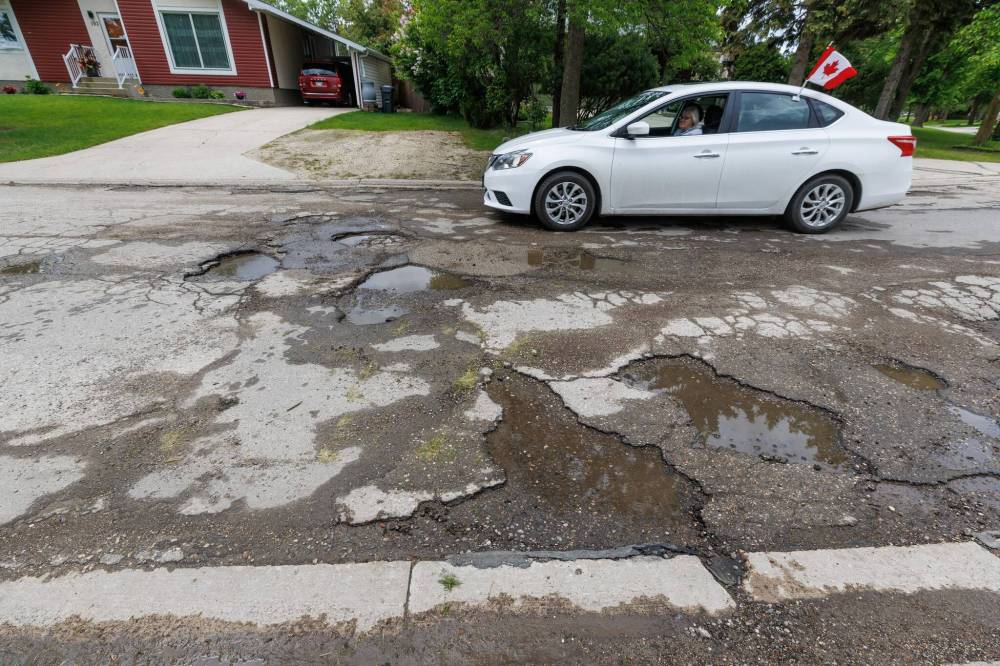
MIKE DEAL / FREE PRESS
The road conditions along the stretch of Augusta Drive between Lakeside and Chancellor drives are poor, in June.
Turns out, the construction crew’s porta-potty didn’t get the memo. It was dropped off at the south end of Augusta in early July.
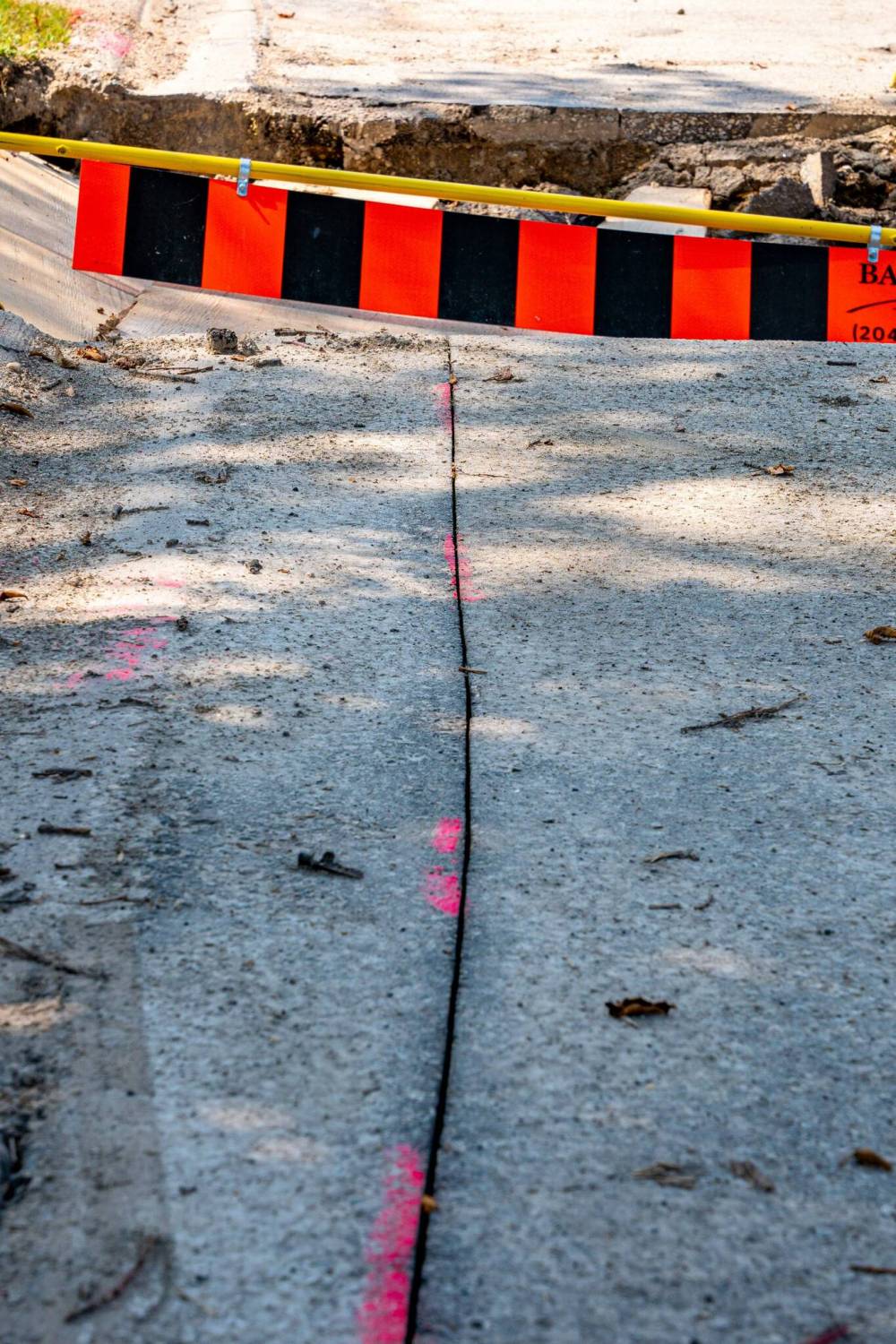
NIC ADAM / FREE PRESS
After a long wait, pothole repairs finally commence along Augusta Drive on Aug. 19.
Pink and purple spray-paint markings began appearing on curbs in early August. They marked the first rehabilitation of the road since it was built in 1979. In the years since, potholes so large motorists swerve to avoid them and water-main-break repairs, including three since 2017, have taken their toll.
“What confuses me… is that I see streets being worked on that don’t look like they need any work done, and we’ve got this down here,” said longtime resident Ken MacIntosh, who has lived on Lakeside Drive, which runs off Augusta, for 43 years. While he was grateful his own street was repaired in 2020, he couldn’t understand why it was prioritized over Augusta, which was in a much worse state.
“I’m happy that it’s done. I’m not sure that it needed to be done, especially when I see areas down there,” said MacIntosh, alluding to Augusta.
For the project’s duration, access is restricted to one lane as work is carried out on the opposite side of the street. On-street parking is prohibited throughout.
That’s something Carol Friesen knows all too well, having to walk — including past a middle stretch of Augusta that was not scheduled for roadwork yet still blocked off — to a neighbouring street to reach her vehicle. (Augusta does not have back lanes.)
“If we’d known exactly what they were doing, it would’ve helped,” said Friesen, who’s lived on the street for more than four decades. “They had concrete right in front of my yard.”
She wants better communication from the city.
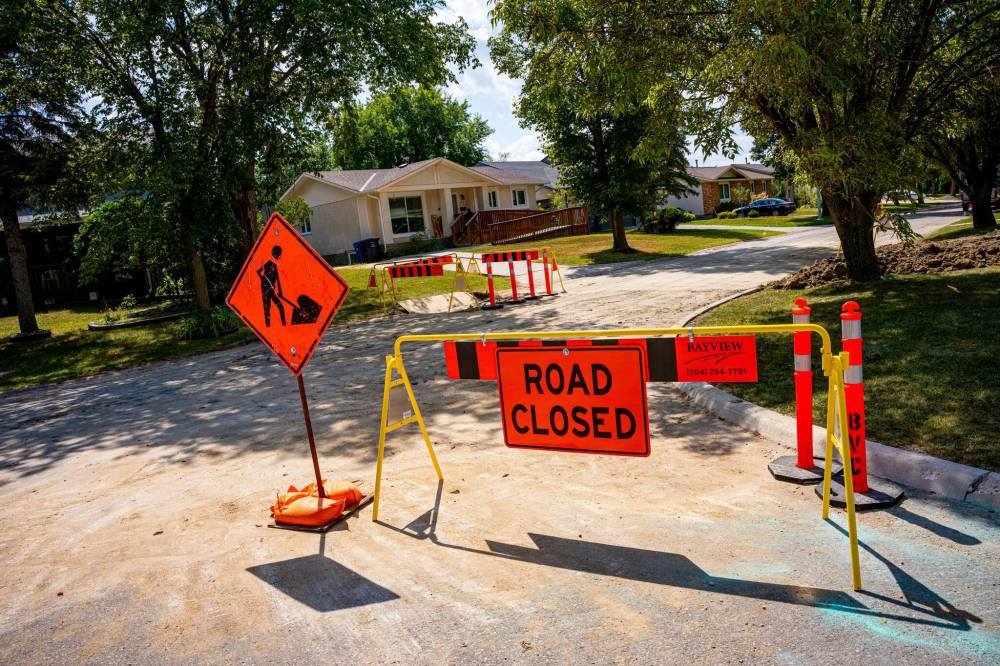
NIC ADAM / FREE PRESS
Potholes plague Augusta Drive in Waverley Heights, as seen in mid-August.
Tatiana Heber agrees. While she doesn’t live on the street, it’s part of her commute.
She didn’t know about the construction until it started. It’s “kind of frustrating,” she said, especially given there was similar roadwork done in the area last year.
Communication continues to be one of the biggest challenges with road construction, said Coun. Janice Lukes, chair of the city’s public works department.
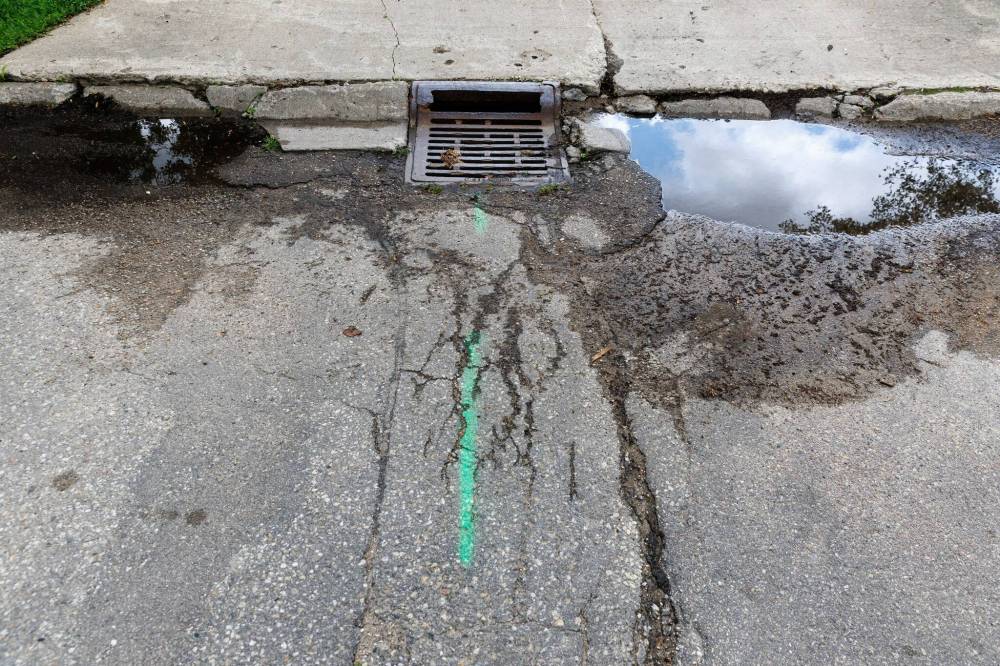
MIKE DEAL / FREE PRESS
Spray paint marks underground pipes at the intersection of Augusta and Greensboro.
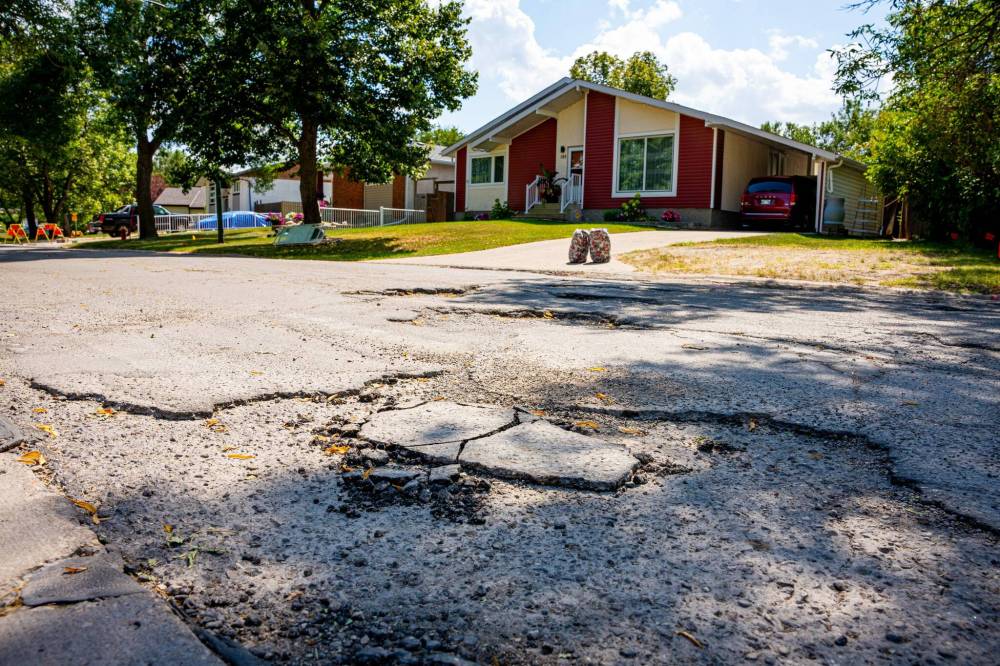
NIC ADAM / FREE PRESS
Potholes on Augusta Drive in Waverley Heights, as seen in mid-August.

NIC ADAM / FREE PRESS
Potholes on Augusta Drive in mid-August.

NIC ADAM / FREE PRESS
After a long wait, pothole repairs finally commence along Augusta Drive in August.
The city mails notices to area residents. The letters include contact information for people to share concerns and submit special requests. Even so, communication and timeframe updates between the city, contractors, residents and businesses remain areas of frustration.
“When the backhoe shows up, everyone knows something is going on,” she said.
The city has improved its online road construction and lane closure maps — but it still needs to do a better job promoting them, Lukes said.
The lane closures map lists upcoming and current road shutdowns, expected start and end dates, and traffic impacts. The road construction map shares preconstruction notices and information about each project’s consultant and contractor.
The latter map tracks project completion rates, though not always accurately. Augusta Drive’s progress sat at zero per cent until at least Sept. 20, despite crews working there for more than a month. It also suggested all of Augusta was scheduled for repairs, when it was only two sections.
A secondary challenge is co-ordination between the city and province, Lukes added: “It’s always looked at but doesn’t always work out for the commuters.”
For example, there were three major projects impacting south Winnipeg residents this summer — the city’s renewal of both Abinojii Mikanah and the St. Vital Bridge, and the province’s ongoing St. Mary’s overpass construction at the Perimeter Highway.
But with a short construction season and funding already approved, it’s best to get shovels in the ground, Lukes said. Delaying only means higher costs down the road.
Back on Augusta, neighbours kept an eye on their upheaved road and the workers — when on the scene — tending to it.
Sophia Kamyszek peered down the empty street on a Monday in September. Orange pylons blocked a lane; gravel lay where curbs were supposed to be.
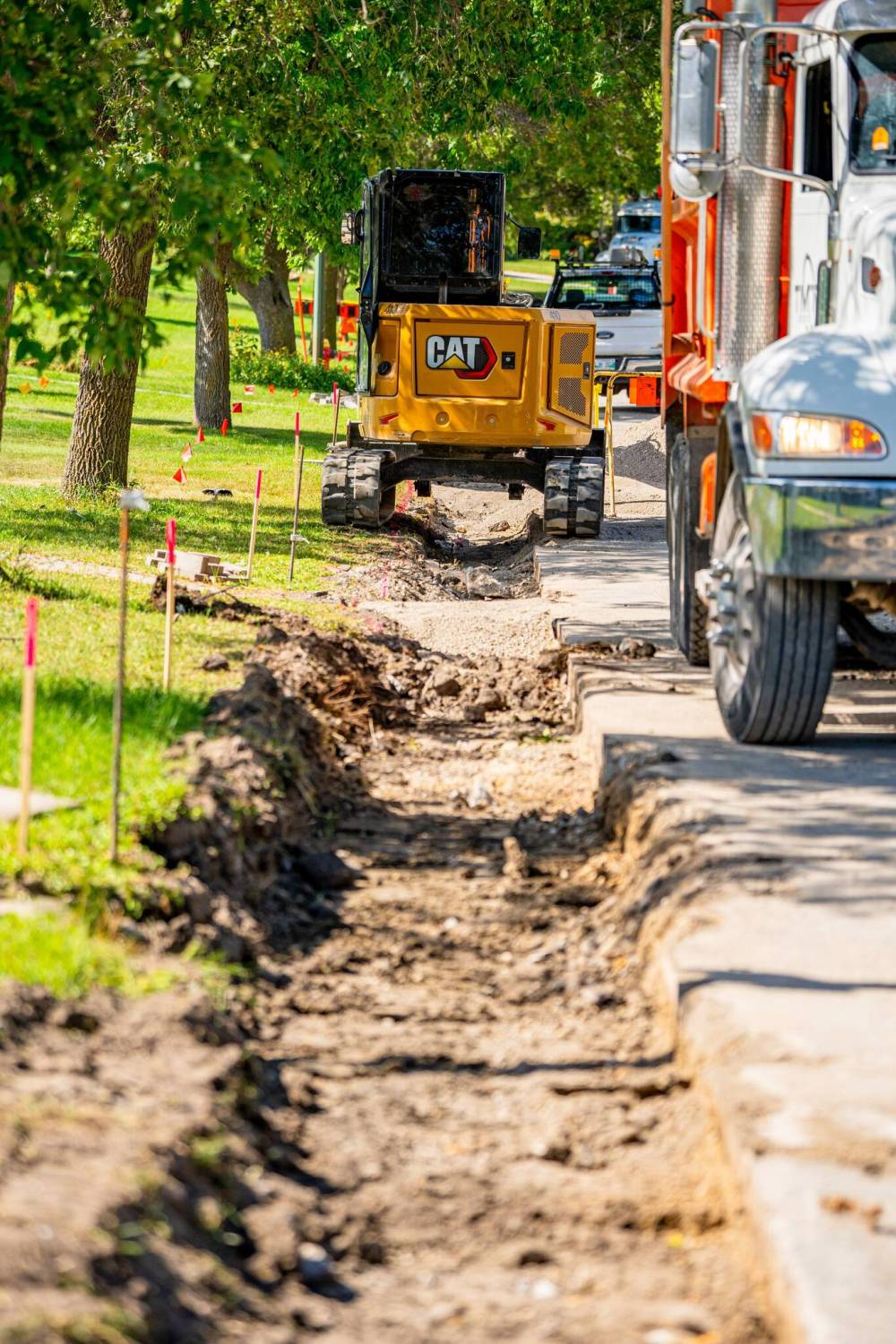
NIC ADAM / FREE PRESS
The project also called for new gutters and wider curbs.
Kamyszek recalled the second city notice she received, informing her work would start in August.
“They’re coming, but look at that,” she said, eyeing the barren road. “They’re not doing anything.”
She clocked construction work on nearby streets. The same firm, Bayview Construction, had signage at each location. Kamyszek correctly surmised they’re working on various jobs at once.
Bayview Construction scored a $3.9-million city contract involving 11 different pavement rehabilitations and five milling projects, including Augusta.
Bayview also had larger projects on the go, including the $12.7-million, two-year rehabilitation of Abinojii Mikanah, between River and St. Anne’s roads.
Bayview declined an interview request.
Industry insiders — speaking on the condition of anonymity — noted a single crew often isn’t designated to a road; groups travel to sites based on their specialty and what’s needed. If one project is thrown off, it has a domino effect on others.

MIKE DEAL / FREE PRESS
Utility flags dot homeowners’ yards in July prior to the start of street repair on Augusta Drive near Arthur A. Leach Junior High School.
“Sometimes the materials are not available, sometimes the crews are not available, sometimes the equipment is not available,” explained Ahmed Shalaby, a University of Manitoba civil engineering professor specializing in pavement design. “We have a limited capacity.”
Scheduling and planning are made more difficult by the lateness with which the city awards construction contracts, said Chris Lorenc, president of the Manitoba Heavy Construction Association.
The city put the Augusta project bundle to tender on April 22, with bidding closing May 7.
Ideally, Lorenc said, 80 per cent of contracts would be awarded to companies by February or March.
“(Then) by the crack of spring we can get to work,” he said.
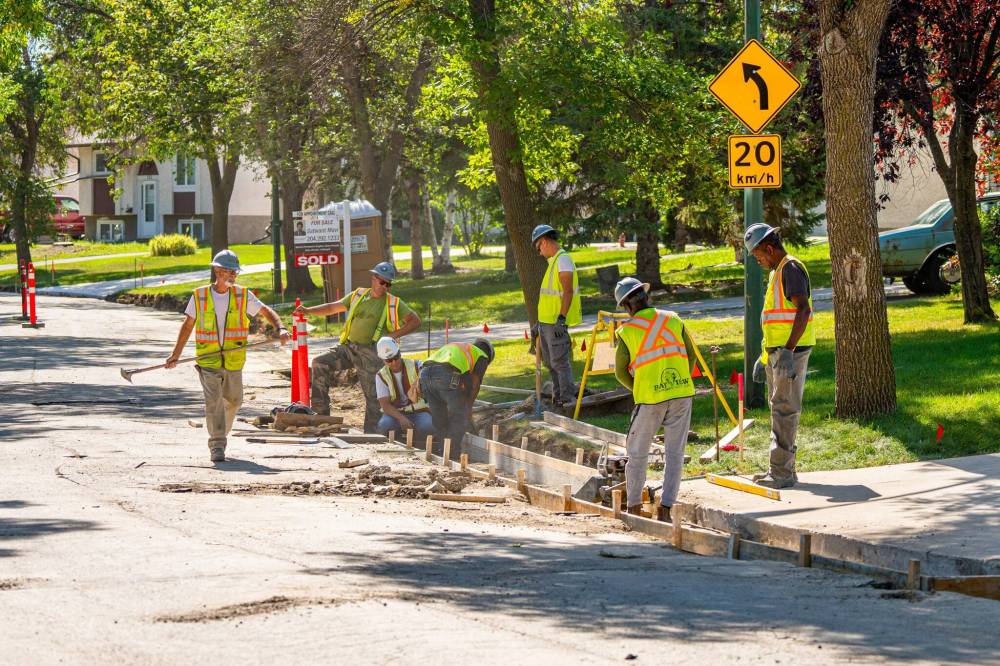
NIC ADAM / FREE PRESS
Construction continues along Augusta Drive on Aug. 26.
The tendering lag cuts into an already short construction season, delays hiring for companies, leads to more expensive contracts and creates the appearance of disorganized construction sites.
“And that will result in what appears to be projects that are pyloned off but there’s no work ongoing,” Lorenc said.
A 2019 City of Winnipeg working group, of which Lorenc was part, had called for contracts to be awarded sooner.
The working group also urged the city to lobby the province to create a registry for buried infrastructure, but that hasn’t happened. The discovery of unexpected underground infrastructure regularly interrupts road construction.
Qualifications-based selection a better way: association
The Association of Consulting Engineering Companies’ Manitoba chapter is working with the City of Winnipeg on incorporating qualifications-based selection (QBS).
QBS isn’t new — it’s actually 52 years old, noted Indra Kalinovich, the Manitoba chapter president. Governments in the United States and Europe have implemented it.
The Association of Consulting Engineering Companies’ Manitoba chapter is working with the City of Winnipeg on incorporating qualifications-based selection (QBS).
QBS isn’t new — it’s actually 52 years old, noted Indra Kalinovich, the Manitoba chapter president. Governments in the United States and Europe have implemented it.
Currently, Winnipeg seeks the lowest bidder for road construction projects, provided the company can complete the work.
The transition to QBS will see city officials inking deals with engineering firms based on who they deem to be most qualified. The upfront price of a road construction project may be higher through the QBS model, but the goal is for the cost to be lower over the infrastructure’s lifecycle, Kalinovich said.
“You wouldn’t necessarily want a surgeon who’s just willing to do it for the cheapest price,” she stated. “We should want the same level of experience and scrutiny for our public infrastructure projects.”
A firm’s experience, knowledge about the local setting, best construction practices, cost-saving approaches and capacity are among the criteria considered when selecting a company for a job.
In metropolitan areas where firms aren’t pre-qualified, companies submit bids outlining their history and capabilities. The City of Winnipeg is currently creating a roster of pre-qualified companies to skip the bidding step, according to Coun. Janice Lukes (Waverley West). The roster will remain open for new firms to join.
“It is meant to be a transparent and open procurement process,” Kalinovich said. “It’s not meant to be that you pick your favourite firm.”
Skipping the bidding process can mean it’s not an open bid — there’s a smaller group of proposals from a pre-qualified pool to choose from, Kalinovich said.
Complicated projects may lead the city to evaluate and rank pre-qualified firms by their proposals for that project. The city would then contact the highest-ranked firm and jointly decide upon the scope of services. This helps define project risk, Kalinovich said.
The city and company will negotiate a project’s scope and cost. If the pair can’t come to an agreement, the city can move to its second choice for the assignment, Kalinovich explained.
The QBS model allows engineers more chances to innovate, she added: “It can be frustrating to be bidding on something knowing that you’ll win with the lowest cost.”
Sometimes the best approach in the long run isn’t the cheapest, Kalinovich said.
— Gabrielle Piché
Lukes said the city is taking measures to get contracts out earlier. She expects most of next season’s contracts will be awarded in March; her eventual goal is for 80 per cent to be done by the end of February.
That’s possible due to a policy shift: previously, engineering firms would bid to be road construction project consultants. Each tender would elicit multiple responses from engineering firms and take seven to 10 weeks to sort through before construction companies could bid on a project, Lukes said.
“It took a lot of staff time,” she explained.
The city is shifting to a qualifications-based selection model. Meaning, the city pre-qualifies engineering companies and gives them projects based on their experience and credentials.
Winnipeg is currently working through the process with the Association of Consulting Engineering Companies’ Manitoba chapter. Ontario and Quebec are among the provinces to employ the model.
“The city will have an understanding of what they expect the (project) cost to be,” Lukes said. “The consultants will, through their experience, have an understanding of what they anticipate it to be. They’ll work together.”
Emerging firms will be delegated basic projects to build experience, Lukes added.
Those steps will help bring a measure of predictability to the tendering process, but Winnipeg’s construction season has always been anything but predictable. Weather — from soggy springs to early snowfalls — remains the biggest hurdle.
This year, rain at start of the construction season delayed the rollout of projects across the city, Lorenc said.
Augusta Drive saw five rain days this summer. Residents took note: “If it rains for like two seconds, they stop,” Friesen said.
However, one construction insider said that’s an unfair criticism. She likened the scenario to a waterlogged sandbox — it feels like clay and your feet start to sink. Heavy equipment can shift the road’s foundation if work resumes too soon, requiring steps to be redone. Sites must undergo testing to ensure they’re fit for construction to resume.
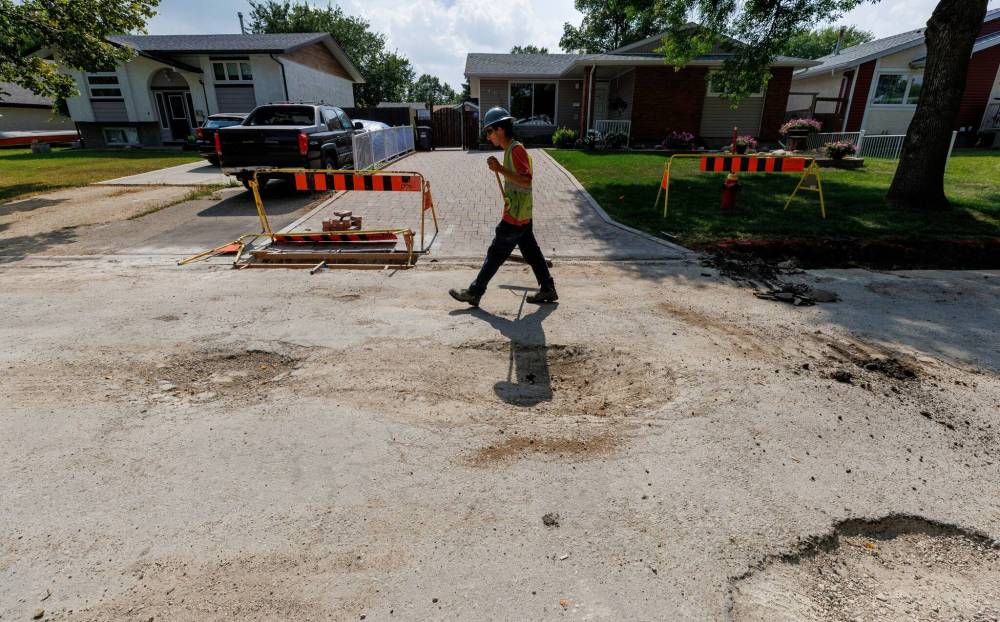
MIKE DEAL / FREE PRESS
Once the project got underway, it proceeded relatively quickly, residents say. But they shared concerns about delays and days of inactivity.
This isn’t the case for all roads — the city recently changed its base specifications to use materials with better drainage, Shalaby said.
The next biggest obstacle is underground infrastructure, from water pipes to power lines to fibre-optic cables. Even with pre-planning and scheduling to move the infrastructure, there are always surprises.
“You can’t see what’s underground until you start digging,” one construction manager said.
Construction companies are allotted a number of “working days” — fair-weather weekdays — to finish a road project. A working day is deemed seven continuous hours.
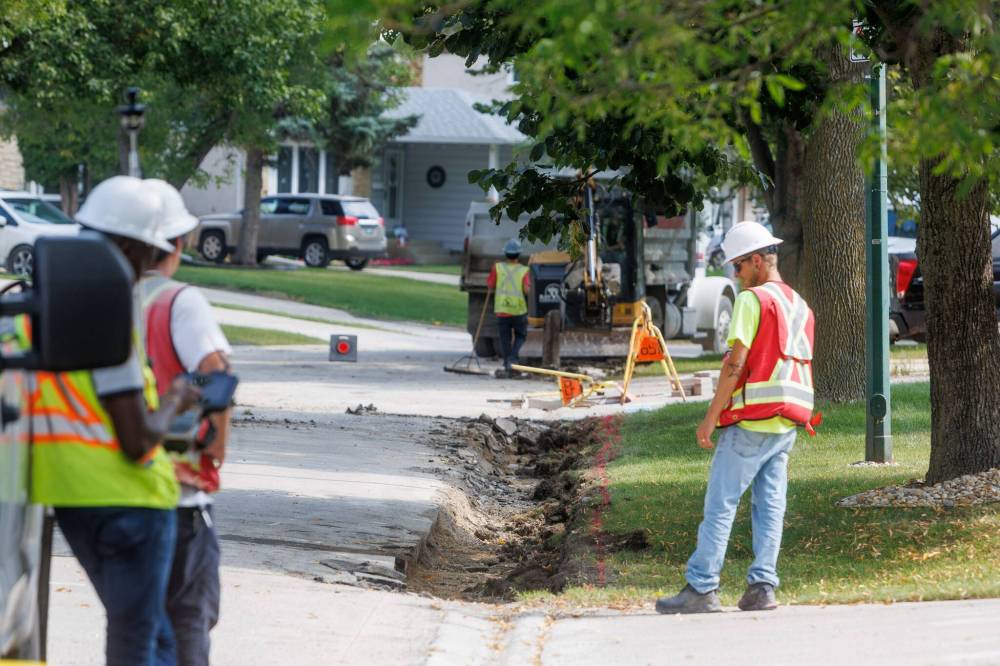
MIKE DEAL / FREE PRESS
Road construction crews work on the stretch of Augusta Drive between Lakeside and Chancellor drives in August.
“If no one’s there, the clock is still ticking on them,” explained Michelle Stainton, a project management engineer for the City of Winnipeg’s public works department.
Working-day caps are baked into contracts. If companies exceed their limit, they’re expected to pay liquidated damages. Fees vary by contract but usually range from $1,500 to $5,000 per day.
“We have definitely had trouble with people getting things done,” Stainton said. “It’s a hassle for us as well… now we basically need to re-tender the project.”
Winnipeg awards contracts to the lowest bidder who can demonstrate they’ll finish the job on time. Those companies may also have projects with the province and private sector — but that’s not a factor in the awarding of a city contract.
Bayview signed for 75 working days to complete its package involving Augusta Drive and 15 other streets. Although the crew hit a snag during excavation — the pavement was in worse shape than anticipated — the company still finished on time.
“While we did initially provide notice that work (on Augusta) was anticipated to begin in July, the notice says it is subject to changes,” Julie Horbal Dooley, the city’s public works communications co-ordinator, wrote in a statement.
“The contractor adjusted their scheduling for the overall package and worked elsewhere first.”
Winnipeg maintains approximately 8,300 km of road, with each assessed and rated every two to three years, said Stainton.
Street cracks are a telltale sign, hinting at further damage underneath.
Winnipeg uses “fairly complex” models to predict pavement life. (Pavement refers to the entire road structure, from the surface to the buried granular layers and even the natural sub-structure soils.)
The models analyze the road data and offer suggestions on how best to divide resources.
City staff then consult with colleagues responsible for other departments, such as water and sewer. When pressing needs overlap, those locations take higher priority.
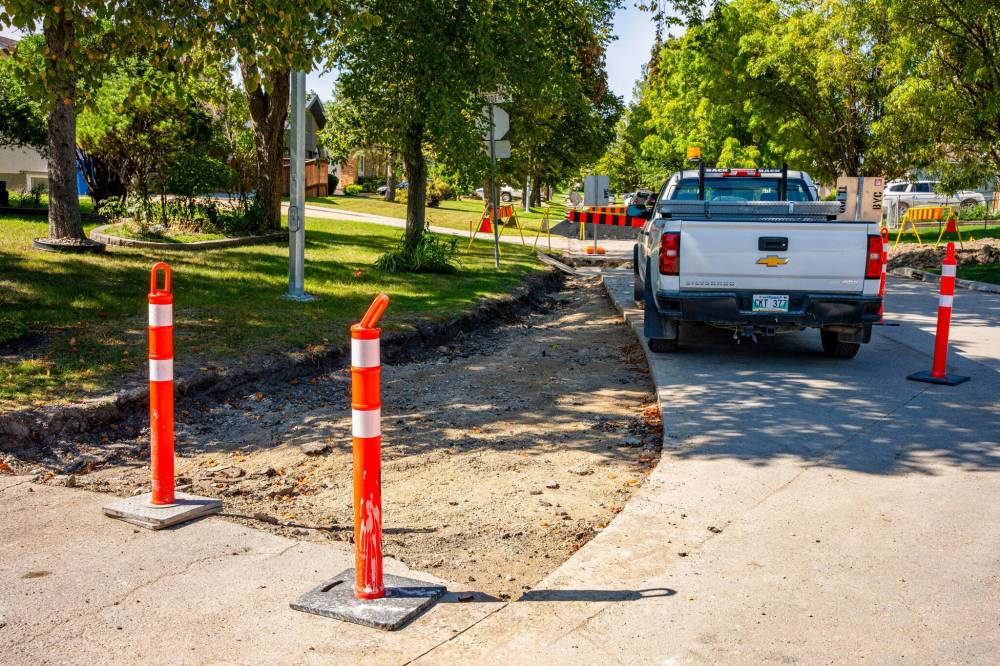
NIC ADAM / FREE PRESS
The entire contract, which included 11 pavement rehabilitations and five milling projects, was expected to be completed within 75 days, a deadline that was met by Bayview Construction.
Street classifications, bus and truck routes, and proximity to schools and recreational centres are among other considerations. Planning for roadwork can begin up to five years before action begins.
Stainton said she hears it all: Why aren’t you doing my street? Why aren’t you doing more on my street? Why are you doing that street again?
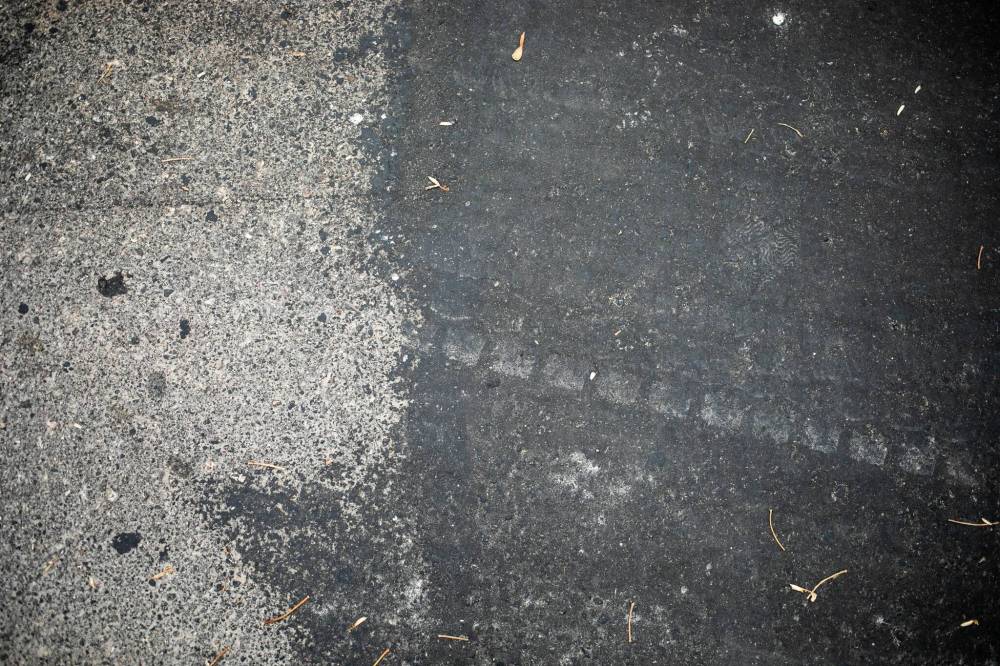
MIKAELA MACKENZIE / FREE PRESS
Freshly paved Augusta Drive near Chancellor Drive at the north end on Oct. 1.
“From a network perspective, it’s the best investment now,” said Stainton, explaining the city’s strategy of prioritizing extending the life of pavement, equating it to preventative maintenance on a house.
“If we do some… less-expensive treatment, but we do it on better pavement, we will extend the life of that and not have to do the most-expensive repair,” she said. “We can push that off to 50 years if it’s properly maintained.”
It’s why some streets seemingly in good condition get repaved — the cost will pay off down the road — while more extensive projects are delayed, as long as the roadway remains safe for travel.
“We could take up our whole budget reconstructing (a complete road overhaul) all the things that need to be done, but… we would ignore all these others that are deteriorating,” she said. “We make a balance to maximize the investment.”
The city’s big-picture philosophy and the small-scale piecemeal approach to the Augusta Drive project further highlight an argument resident Michel Durand-Wood has been advancing in recent years.
Winnipeg simply has more infrastructure than it’s capable of maintaining and not enough funds — nor do local construction crews have the capacity to meet all of the city’s needs, said Durand-Wood, who writes about municipal decision-making and finances.
“There’s always a discussion about getting more money, but when we actually settle down to find out how much more it would take… it’s a number that just doesn’t make sense.”
He believes a “complete re-evaluation” of how people and goods move throughout the city is needed. More walking, biking and busing are crucial, he said.
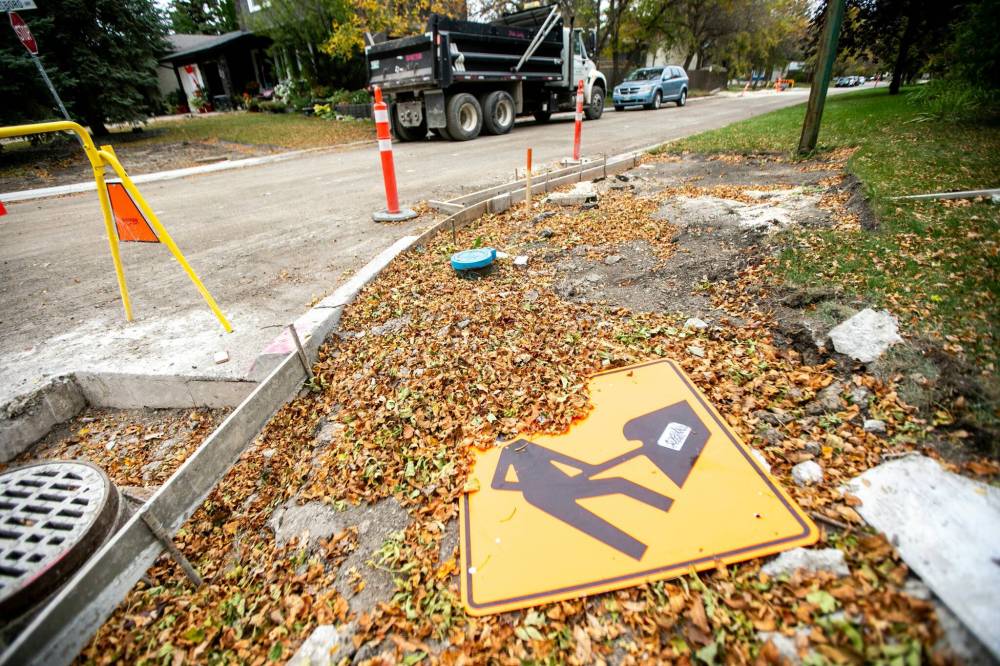
MIKAELA MACKENZIE / FREE PRESS
Construction at the end of Augusta Drive, near Greensboro Bay, on Oct. 1.
The city is set to implement its new Winnipeg Transit plan in June of 2025. As the city transforms its bus-route grid, it will increasingly prioritize the maintenance of those streets, Lukes said.
“We want the roads to be safe for the major volume of traffic travels,” Lukes said, adding she doesn’t believe the focus on transit-oriented roads will take away from residential streets.
Winnipeg sees a “tremendous volume” of roadwork, from Lukes’ viewpoint. The road construction budget has grown from some $50 million, before Lukes became a councillor in 2014, to upwards of $100 million regularly.
“In the big picture, I think Winnipeg is doing well,” Lukes said. “Of course, people are going to get frustrated, but thank goodness we have the funding to do it.”
It’s Oct. 27. Brian Jowett whizzes down Augusta Drive on his power wheelchair.
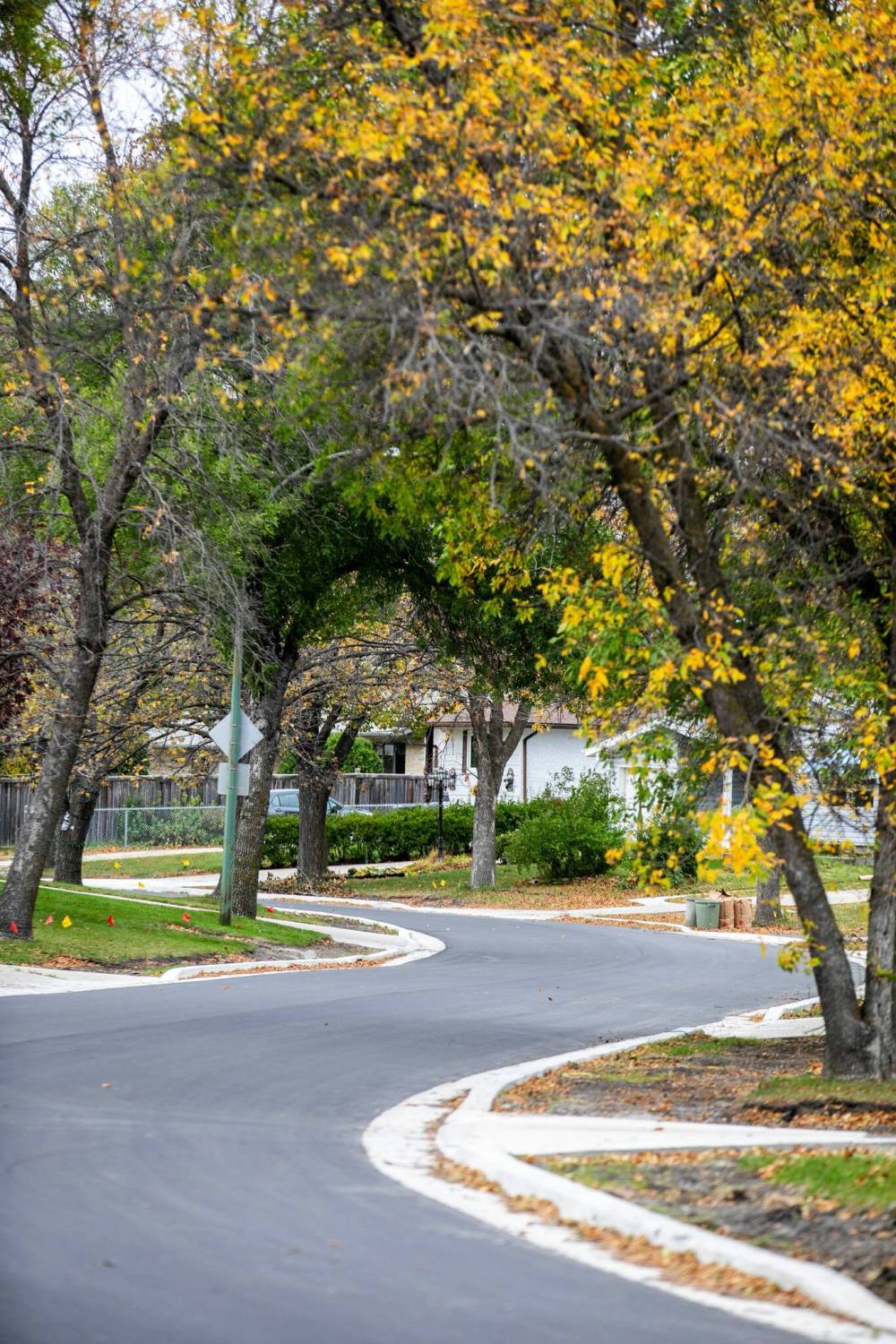
MIKAELA MACKENZIE / FREE PRESS
The road project was essentially completed by mid-October, though residents were still waiting for lawns to be re-sodded.
The road is a deep black, the curbs a bright grey. Even an offshoot of Augusta Drive, Providence Place, is free of construction signage and pylons. Bayview crews finished repaving Providence about 10 days earlier.
Paving of Augusta Drive finished in the first half of October, some three months after residents believed the work would begin.
Jowett avoided the construction-laden strip during the summer and fall. Getting rides was a problem, too — even though his stretch of Augusta wasn’t slated for repair, it was still blocked off.
Despite the inconveniences, Jowett expressed gratitude for now having a safer road. The former version of Augusta — with its wide, deep potholes, threatened to flip his wheelchair.
“I always came close,” he said. “The whole thing would’ve fell.”
For the middle-class neigbhourhood, where property taxes average around $4,000 annually, it’s a small victory.
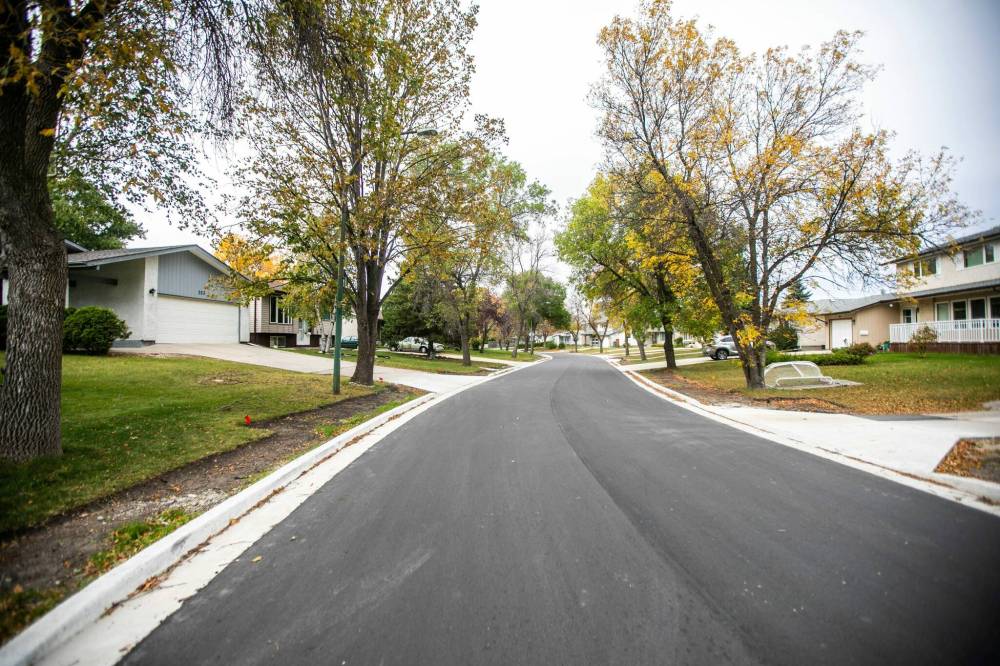
MIKAELA MACKENZIE / FREE PRESS
Freshly paved Augusta Drive between Chancellor and Lakeside drives in October.
Despite the delays and inconveniences, residents got to witness their tax dollars at work in a city where infrastructure progress isn’t always apparent.
A 75-day contract, approximately 1,000 metres of work, or about 13.3 metres a day. And the cost? The city wouldn’t provide a specific number, but instead pointed to the overall cost of the 16-project bundle in which Augusta was included. (The $3.9-million bid involved repaving 6.1 km of road.)
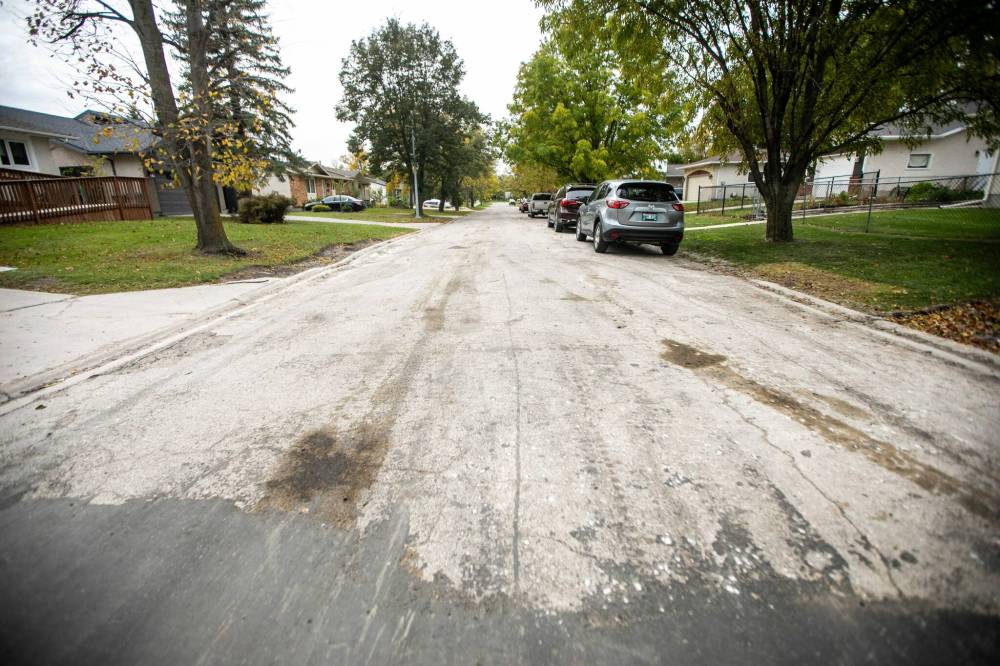
MIKAELA MACKENZIE / FREE PRESS
Some neighbourhood residents questioned why the whole street wasn’t repaved.
A few days earlier, Girard James looked out at the freshly paved street, pausing from fixing his car. He’d been wishing for the road to be redone since he moved to the neighbourhood seven years ago.
“When they finally did it, they really went good and fast,” James said. “I was happy with how fast it went. I mean, it’d be nice if they would do the grass. I’d be real happy.”
Yes, the roadwork is done, but the job isn’t completely finished, not with gaps left in residents’ lawns.
James had hoped crews would sod the area before winter.
Maybe if construction started in July, he wondered aloud, it would be done already.
gabrielle.piche@winnipegfreepress.com

Gabrielle Piché
Reporter
Gabrielle Piché reports on business for the Free Press. She interned at the Free Press and worked for its sister outlet, Canstar Community News, before entering the business beat in 2021. Read more about Gabrielle.
Every piece of reporting Gabrielle produces is reviewed by an editing team before it is posted online or published in print — part of the Free Press‘s tradition, since 1872, of producing reliable independent journalism. Read more about Free Press’s history and mandate, and learn how our newsroom operates.
Our newsroom depends on a growing audience of readers to power our journalism. If you are not a paid reader, please consider becoming a subscriber.
Our newsroom depends on its audience of readers to power our journalism. Thank you for your support.